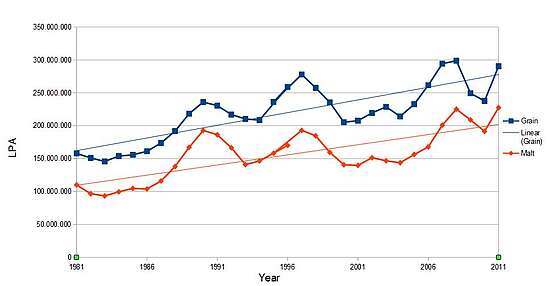Single Malt Whisky Is Successful! Scotch Whisky in 1,000 Variations
Single Malt Whisky is gaining a large audience. Globaly the Scotch Malt Whisky is the leader of the Sinlge Malt Whisky production. The Malt Whisky production rose from 110 million liters of pure alcohol (LPA) in 1981 to 254 million LPA in 2012. What is so special about Single Malt Whisky? If you ask a connoisseur, they'll tell you it's the extraordinary variety of flavours.
1. Smokiness
The distillery decides whether after germination the malt is dried with neutral hot air or over peat smoke. There are non-peated, medium-peated and heavily peated Malts.
2. Fermentation
Sugar is extracted from the ground malt with hot water. After cooling down, yeast is added for fermentation. But not all yeasts are the same. Each yeast produces alcohol but also different aromatic substances. Some yeast strains produce fresh, fruity components such as apples, pears or citrus fruits; others produce fresh flower or grass aromas. Beside fresh aromas there are also riper aromas such as plums, apricots and berries. And then there are strains that produce complex, spicy aromas.
3. Shape of the Pot Stills
In the pot stills alcohol and aromatic substances are distilled from the beer. Water, fusel oils and unwanted flavour substances remain in the stills. The shape of the pot stills is important. Tall and slim or short and bulgy - different shapes lead to light, medium or heavy Malts.
4. Method of Distillation
Distillation intensifies the aromas of the yeasts. It can be short and intense or long and gentle.
5. Choice of Casks
Scotch wWhisky is stored in used oak casks. The taste of fresh casks would be too intense. Instead, milder second-hand casks are used. The most common casks are Bourbon casks, which have already been used to store Whiskey for 2 to 4 years. Before being used, Bourbon casks are heated for some time and then charred for a short period of time. This heats up the wood, and the wood sugar caramelises, which makes the Whisky brown. The fire turns the lignin of the wood into the chemically related vanillin. In Bourbon its taste is obvious, but also in Single Malt it's often still noticeable. The charcoal layer on the inside of the cask doesn't lead to a smoky Whisky. Instead, it mainly filters out the pungent components from the Whisky.
The second cask type is the Spanish Sherry cask. The Whisky also extracts flavours from
Sherry cask walls, resulting in Sherry aromas from sweet to dry.
Page about Cask Maturation
6. Storage
The last big influence is storage. Over the decades, the fresh aromas are turned into ripe aromas, the smokiness decreases, and the Whisky extracts more and more substances from the cask wall. The cask wood is effectively leached out.
The surroundings also have a particular influence on the Whisky. When the cask is heated up in summer, air is pressed out of the cask through the pores of the wood. Thus approximately 1% of the Whisky evaporates per year.
When it cools down in winter, the cask absorbs surrounding air again. If the cask is stored close to the sea, the air contains additional aromas such as iodine. But also the smell of kelp and sea grass can be found in the Whisky.
The temperature differences in the moderate Lowlands aren't as huge as in the rough Highlands. In the higher regions of the Highlands the cask breathes more.
Smokiness, fermentation, pot stills, casks and storage have a big influence on the taste of the Whisky. If we assume three different intensities for each of the 5 influences (slight, medium, strong), we get 3*3*3*3*3 = 243 different Whiskies.
However, the 5 influences mentioned here are only the most important ones. There are many others such as malt quality, duration of fermentation, number of pot stills, cask size or warehouse type. If we again assume 3 possibilities for these 5 additional influences, the number of variants already grows to 60,000.
With this flavour variation, almost each Whisky cask is unique. That's the very individuality the Whisky connoisseur appreciates. Each bottle holds a surprise. Whether it is light and mild before dinner or intense after a lavish meal - for each occasion there's the right companion. That's the secret recipe for the enormous success of Single Malt Whisky all over the world.

